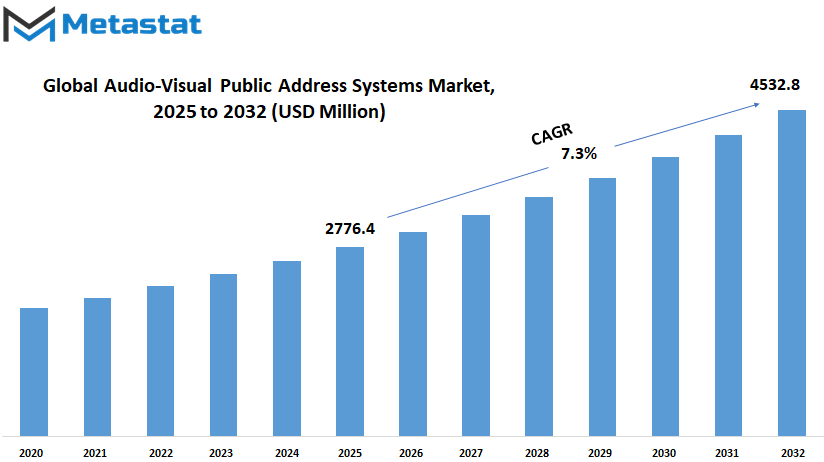MARKET OVERVIEW
The global audio-visual public address systems market will remain at the forefront of shaping the way institutions, venues, and businesses organize mass-scale communication with the help of combined audio and video technologies. The market is aimed at systems that provide announcements, directions, and multimedia content in distributed environments, fusing sound reproduction with display solutions to connect with masses effectively. It will cater to public facilities, schools, corporate buildings, transportation centers, and entertainment venues dependent on coordinated and high-quality audio-visual output.
The global audio-visual public address systems market will evolve based on systems capable of managing voice and content delivery between zones, buildings, or campuses. Solutions will be designed to provide clarity, range, and operational freedom. Market products will comprise microphones, amplifiers, speakers, display panels, controllers, and network-based platforms supporting centralized or automated control. Solution providers and system integrators will customize installations based on space dynamics, acoustics, and targeted communications requirements.
The global audio-visual public address systems market will target needs from high-traffic spaces including airports, train stations, arenas, colleges, and government facilities. In these areas, the need to provide concise and timely messaging will be critical both for everyday communication and crisis management. Pre-configured units will accommodate bilingual or region-based announcements, play once operations, and remote-control capabilities. Interactive display components will be integrated into most installations to maximize visual impact and message retention.
Product innovation in the global audio-visual public address systems market will concentrate on integration, ruggedness, and system expandability. Equipment will be built with support for long runtimes, changing environmental conditions, and possible expansion across multiple zones. Hybrid systems that can handle live announcements and pre-recorded broadcasts will become the norm in most deployments. Solutions will also evolve to accommodate wireless connectivity protocols, providing flexibility in installation and mobility within small or modular spaces.
Technological advances will impact the performance and dependability of these systems. Software platforms for controlling content playback and scheduling will have intuitive interfaces and real-time diagnostics. Remote access via secure networks will enable operators to view and make adjustments to systems remotely. Artificial intelligence and automation will increasingly be applied for crowd control pattern recognition, alert sequencing, and adaptive sound balancing, especially in dynamic acoustical environments.
The global audio-visual public address systems market will grow through service-based models as well as direct installations. Solution providers will provide packaged solutions such as installation, design consulting, testing, and long-term maintenance. Educational institutions, corporate campuses, and transportation authorities will look for vendors that can provide compliant systems that fit their operational codes as well as their safety regulations. Licensing needs and infrastructure mandates will shape product certifications and system architectures across jurisdictions.
Geographically, the global audio-visual public address systems market will exhibit regional differences in technology adoption, building codes, and communication standards. Urban areas with high-density infrastructure will need high-capacity systems, while smaller towns and developing countries will need low-cost configurations that achieve minimum communication objectives. Software localization, content flexibility, and interface adaptability will define product competitiveness across borders.
The global audio-visual public address systems market will remain at the center of communication plans for contemporary infrastructure. Through technological design and local adaptation, the market will deliver solutions for supporting operational continuity, crowd safety, as well as messaging effectiveness across various sectors.
Global audio-visual public address systems market is estimated to reach $4532.8 Million by 2032; growing at a CAGR of 7.3% from 2025 to 2032.

GROWTH FACTORS
The global audio-visual public address systems market is expected to experience robust growth over the next few years because of the growing demand for effective communication systems in different industries. With societies getting bigger and cities becoming more populated, the demand for efficient public announcement systems should continue to increase. These systems are increasingly being used in schools, airports, shopping malls, company buildings, and government offices due to their effectiveness in disseminating information clearly and fast to large groups of individuals. With advancements in audio and visual technology, such systems are becoming more sophisticated and easier to operate, which contributes to their rising popularity.
One of the primary reasons for this growth is the greater emphasis on public safety and instant communication. Governments and private institutions are spending on systems that provide alerts and updates instantly, particularly in times of emergencies. In addition to this, growth in smart infrastructure and intelligent buildings is also contributing to the demand for these systems. Those buildings now are being constructed to accommodate built-in communication networks, and audio-visual public address systems have an important role to play in that configuration. With cities becoming increasingly digitally integrated, usage of the systems is bound to become even more critical.
Still, there are a couple of issues that can hamper this advancement. The first is that installation and maintenance come at a pretty hefty price tag. Not all firms, particularly in less developed regions, might be willing to invest in these systems. The second problem is the absence of standard rules and system compatibility, which can make it difficult to employ the same configuration in different buildings or territories. These considerations might deter some customers from switching or from replacing their current systems.
In spite of these challenges, the global audio-visual public address systems market is anticipated to be aided by the growing interest in smart cities and automation. With growing regions seeking digital transformation, they will require equipment that enables quick and efficient communication. The incorporation of artificial intelligence and remote access capabilities in public address systems will provide new opportunities for users. These developments can enhance not just safety and awareness but also facilitate the users to operate systems more easily and flexibly. In the future, the global audio-visual public address systems market will expand more as more industries discover the worth of these systems and how they can cater to routine and critical needs of communication.
MARKET SEGMENTATION
By Type
The global audio-visual public address systems market will also expand steadily with more industries and public infrastructures shifting towards intelligent communication solutions. With changes in technology affecting how people communicate and exchange information, there will be greater emphasis on the way announcements and visuals are communicated together in real-time. The systems are not only applied in making announcements but also in guiding, informing, and making people safe in public and private settings.
In the future, various kinds of systems will serve distinct purposes. Wired Audio-Visual PA Systems, which are stable, will continue to be preferred where stability and continuous service are of utmost concern, like in airports or huge campuses. Wireless Audio-Visual PA Systems, however, will be in the limelight for their flexibility and simple installation, a good option for temporary installations or locations where it is hard to lay down cables. With enhanced signal quality and longer battery life, these systems will become even more reliable.
IP-based Audio-Visual PA Systems will be used extensively because they provide greater control and remote monitoring with ease. They will be able to be linked to other systems using common internet protocols, enabling centralized management from multiple locations. Networked or Cloud-based Audio-Visual PA Systems will also increase in usage since they will be able to store and deliver content without the need for local servers. They will provide an easy means to maintain software updates and broadcast announcements between cities or even nations from one point.
Integrated PA & Display Systems will become increasingly prevalent in smart buildings and transportation hubs. They will assist in showing messages, live updates, and alerts in clear manner, as well as playing audio simultaneously. These systems will enable more efficient and faster communication, particularly in areas where visual information is just as crucial as what is being heard. At the same time, Analog Audio PA Systems with Visual Add-ons will continue to find a niche, particularly in slow-upgrading facilities. Being able to add visual capabilities to existing installations will enable companies to upgrade without completely replacing older systems.
With more industries investing in intelligent infrastructure, the global audio-visual public address systems market will grow. It will not only react to increasing communication demands but also define the way information is exchanged in public, work, and business spaces in the future.
By Application
The global audio-visual public address systems market is projected to continue growing steadily as the technology gets better and the demand for effective communication increases. With new requirements arising in industries, the systems will not only be used for announcements but much more. Their use in emergency communications and evacuation attempts will be critical. Where rapid and concise communication is required, such systems assist individuals in being directed safely and calming panic. As the world experiences more natural disasters and unanticipated happenings, the importance of dependable audio-visual communication in times of crisis will increase.
Displaying information in real-time is also an area where these systems will have a more significant role. Individuals expect instant updates today, either at airports, stations, schools, or entertainment areas. The ability to answer accurately and quickly will enhance public experience and confidence. With an increasing number of spaces being digitally networked, this feature will move from an added capability to a minimum requirement. Even slight delays in communication lead to confusion, and hence these systems will have to function with accuracy.
Application of these systems to entertainment and announcements will also continue to grow. Malls, stadiums, events, and even theme parks rely on good sound and video to keep individuals informed and entertained. As expectations rise among audiences, these systems will have to accommodate improved sound quality and sharper images. Personalization and adaptability will become more prevalent so they can accommodate various locations and uses.
For transport alerts, these systems currently have an important role to play, but their significance will increase. There is an increasing number of cities that are working to enhance public transportation, and unambiguous communication forms part of this endeavor. Whether it is alerting passengers to delays or route changes, audio-visual alerts will minimize confusion. With growing urban populations, having efficient systems in place will enhance better travel experiences.
Digital signage integration will be more integrated into these systems. Instead of existing separately, screens and speakers will be controlled in tandem. This will be beneficial for smoother control of messaging and less likelihood of conflicting messages. Companies and public services will see an advantage from this integration, particularly when fast updates are necessary.
Security and surveillance coordination will also be enhanced by these systems. They can be integrated with cameras and alarms to act more quickly in risky situations. This will enable real-time direction through both audio and pictures, assisting individuals in remaining secure. The global audio-visual public address systems market is progressing toward smarter, more interactive communication that integrates into the rapid pace of life in the future.
By End User
The global audio-visual public address systems market is slowly becoming increasingly important as technology continues to shape how spaces are run and how information is disseminated to the masses. Audio-visual public address systems aid in delivering announcements, warning signals, and instructions to a large audience in normal and crisis situations. In the future, the global audio-visual public address systems market will experience consistent alterations due to increasing public safety needs, demands for quicker communication, and increased demands for clear and seamless audio-visual experiences in public as well as private areas.
With society continuing to expand and move towards more intelligent settings, various industries are beginning to depend increasingly on sophisticated public address systems. In transit centers such as airports, train stations, and bus stations, these systems are the backbone. Whether directing travelers, providing updated travel timetables, or facilitating fast response in case of emergencies, effective communication is a priority. As more individuals are on the move within these congested spaces, there will be increased pressure for more trusted and high-quality audio-visual installations.
In schools, these systems are being utilized not just for day-to-day school messages but also for informing students and staff in times of crisis. They assist in everyday operations such as assemblies, events, and class changes. Down the line, schools and colleges will anticipate systems that are simpler to manage and more integrated with other technologies installed.
Industrial plants tend to have large grounds, and quick and precise communication is highly essential for safety and coordination. As industries start getting automated and are increasingly dependent on networked equipment, public address systems will become more intelligent, integrating with sensors and control systems for quicker warning and notifications.
Governmental buildings and public facilities rely on steady and reliable systems of order and security. As these buildings strive to enhance security and communication among all the citizens, there will be greater interest in improved sound coverage and visual support that is more comprehensible for all types of audiences.
Shopping centers and business premises are concerned with safety and customer satisfaction. For promotions, general announcements, or emergency instructions, quality audio-visual systems assist in maintaining smooth operations. In health facilities, prompt and peaceful communication can be a matter of life and death, so having a system that guarantees speedy and clear warnings will become all the more critical.
Stadiums, hotels, and hospitality venues also take advantage of such technologies by enhancing the guest experience, regulating crowds, and directing individuals clearly. The global audio-visual public address systems market will still expand to cater to these changing demands.
|
Forecast Period |
2025-2032 |
|
Market Size in 2025 |
$2776.4 million |
|
Market Size by 2032 |
$4532.8 Million |
|
Growth Rate from 2025 to 2032 |
7.3% |
|
Base Year |
2024 |
|
Regions Covered |
North America, Europe, Asia-Pacific Green, South America, Middle East & Africa |
REGIONAL ANALYSIS
The global audio-visual public address systems market is gradually gaining prominence with the increasing communication requirements across different industry sectors. In the future, the global audio-visual public address systems market will keep increasing as cities get smarter and more integrated. These systems will be required in schools, hospitals, transport stations, and public establishments, where there must be clear communication for day-to-day operations and security. The global audio-visual public address systems market will also be able to gain more from enhanced technology, such as wireless communication, improved sound quality, and simplified control through intelligent devices. This will make the systems even more beneficial in emergencies and non-emergency scenarios.
Geographically, the global audio-visual public address systems market is segmented into a number of regions, which have their respective rates of development. In North America, the U.S., Canada, and Mexico will also experience consistent growth, with the U.S. most likely to lead because of its solid infrastructure and rapid uptake of new technology. Europe, which includes the UK, Germany, France, and Italy, will also exhibit robust interest in upgrading public safety and communication equipment, particularly urban regions. With changes in environmental conditions and population density, the demand for rapid and reliable communication will gain importance.
India, China, Japan, and South Korea will dominate the future of the audio-visual public address systems market in the Asia-Pacific region. Urban growth at a fast pace coupled with government spending on smart city initiatives will fuel the application of public address systems. These nations are populous and have issues such as disaster management and congested public transport. Consequently, there will be a strong impetus to install systems that will be able to reach masses of people in an efficient manner and make them heard.
South America, and Brazil and Argentina particularly, will also exhibit improvement, though the rate may be slower based on economic environment and the level of investment. These countries are becoming more concerned with public safety, and this will push the use of sophisticated communication systems. The Middle East and Africa, such as the GCC nations, Egypt, and South Africa, are starting to look into new methods for enhancing public infrastructure. With cities growing and people gathering in the streets more often, these regions will require dependable systems to control large areas and provide safety.
On the whole, the global audio-visual public address systems market is destined to grow in the long run. As various regions become accustomed to new communication issues, such systems will find a crucial position in public life, determining the ways in which information is disseminated during tranquil and desperate situations alike.

COMPETITIVE PLAYERS
The global audio-visual public address systems market is trending towards an era where technology, convenience, and smart design take center stage. As technology evolves constantly and shapes the way we engage with sound and visual communications, businesses operating in this sector are discovering new ways of addressing the evolving demands of public, commercial, and private establishments. These systems are no longer restricted to casting announcements only. Rather, they are becoming intelligent communication devices that enable effective coordination, emergency management, and engaging experiences for individuals in different environments.
Bosch Security Systems, LLC and TOA Corporation are already demonstrating a strong willingness to enhance the reliability and extent of their products. Their emphasis has been on developing systems that will work effectively even in complicated circumstances, assisting in the mission of keeping messages clear and on schedule. Honeywell International Inc. and AtlasIED are making investments in easy-to-use controls and enhanced connectivity, which will probably make them simpler to operate for small venues and large institutions.
Zenitel Solutions and Harman International, owned by Samsung, are exploring the addition of voice clarity improvement and more extensive connectivity options, demonstrating that future communication systems will be more responsive and flexible. Baldwin Boxall Communications Ltd. and Ahuja Radios are continuing to advocate for improved hardware that strikes a balance between performance and longevity. At the same time, Barix AG and Guangzhou DSPPA Audio Co., Ltd. are concentrating on compact sizes and wireless capabilities, which will simplify public address systems to install and use in many environments.
Bose Corporation and Yamaha Unified Communications are applying their sound knowledge to enhance the listening experience in public messaging. This careful consideration will make messages penetrate listeners better, particularly in noisy or crowded areas. Biamp Systems, LLC and Extron Electronics also play a part in providing systems that can be controlled on multiple platforms, providing flexibility for users who must control audio-visual features remotely or over vast buildings.
PVS N.V (Audac) is just one of the firms that is developing access to top-notch sound systems without pricing them beyond reach. This action can provide more possibilities for small enterprises or community centers to embrace new solutions. In the future, the emphasis throughout the global audio-visual public address systems market will most likely continue to be on cleverer systems, more seamless controls, and better sound coupled together by competitive players that are defining how individuals interact and communicate.
Audio-Visual Public Address Systems Market Key Segments:
By Type
- Wired Audio-Visual PA Systems
- Wireless Audio-Visual PA Systems
- IP-based Audio-Visual PA Systems
- Networked/Cloud-based PA Systems
- Integrated PA & Display Systems
- Analog Audio PA Systems with Visual Add-ons
By Application
- Emergency Communication & Evacuation
- Real-time Information Display
- Entertainment & Announcements
- Transportation Alerts
- Digital Signage Integration
- Security & Surveillance Coordination
By End User
- Transportation Hubs (Airports, Railways, Bus Terminals)
- Educational Institutions
- Industrial Facilities
- Government & Public Infrastructure
- Commercial Complexes & Retail
- Healthcare Facilities
- Stadiums & Large Venues
- Hospitality & Resorts
Key Global Audio-Visual Public Address Systems Industry Players
- Bosch Security Systems, LLC
- TOA Corporation
- Honeywell International Inc.
- AtlasIED
- Zenitel Solutions
- Harman International (Samsung)
- Baldwin Boxall Communications Ltd.
- Ahuja Radios
- Barix AG
- Guangzhou DSPPA Audio Co., Ltd.
- Bose Corporation
- Yamaha Unified Communications
- Biamp Systems, LLC
- Extron Electronics
- PVS N.V (Audac)
WHAT REPORT PROVIDES
- Full in-depth analysis of the parent Industry
- Important changes in market and its dynamics
- Segmentation details of the market
- Former, on-going, and projected market analysis in terms of volume and value
- Assessment of niche industry developments
- Market share analysis
- Key strategies of major players
- Emerging segments and regional growth potential








 US: +1 3023308252
US: +1 3023308252






